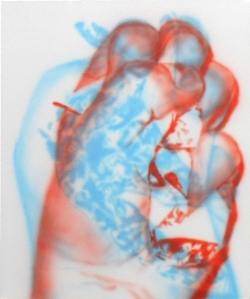Artists have found inspiration in love, pain, landscape, death, and history, but it's safe to say Mariano Molina is one of the first to find his muse in neuroscience.
Molina, an artist well known in his homeland of Argentina for paintings that bend perception, spent five months working to better understand how people perceive art with Rodrigo Quian Quiroga, an Argentine neuroscientist at the University of Leicester in the United Kingdom. "There are so many things artists have known for centuries that neuroscience is just beginning to know," Quian Quiroga says. "Artists have an intuition that scientists simply don't have."
 |
By Mariano Molina |
In 2008 Quian Quiroga collaborated with University of Leicester social anthropologist Sandra Dudley and David Barrie, former director of the Art Fund in the UK, to investigate the "wow factor" that some experience when looking at a piece of art in a museum. They wanted to understand how the eyes and brain react to the fluid strokes of a Georiga O'Keefe flower, or the thick, chucky globs of paint in Vincent van Gogh's "Starry Night." Could the lighting in the museum or the knowledge of the artist's fame affect an individual's reaction?
From November 2009 to April 2010, Molina was a resident artist in Quian Quiroga's lab. Molina says his visit began with a lot of reading about the neuroscience of visual perception. After a couple of months, Quian Quiroga introduced Molina to the eye tracker, a camera used in neuroscience that looks into the eye, detects slight movements in the retina, and correlates them to the location of the gaze on a picture.
"When you look at something," says Quian Quiroga, "your eyes move around looking at different pieces of the picture at a time, and then your brain reconstructs the whole image. With the eye tracker, Molina was able to see what parts of his painting people were paying the most attention to." If an observer's eyes concentrated on sections of the painting Molina felt were most important, his technique had worked; if not, he could highlight or dull certain areas, and try the eye tracker again to see if the changes made a difference.
Molina says the eye tracker fascinated him because "it was like people were painting with their eyes."
In "The Center of Gaze," Molina blurs the painting to a center point where figures of people can be seen cheering and smiling. When Molina tested the effectiveness of his technique with the eye tracker, people's eyes spent most of their time on the clear center, the response he had hoped to achieve. Without any prior knowledge of how the brain perceives images, Molina was aware of the response he was creating in people, says Quian Quiroga.
 |
generated by the eye tracker |
 |
By Mariano Molina |
Quian Quiroga introduced Molina to theories in neuroscience that inspired other paintings. The aptly named "Binocular Rivalry Hands" applies a theory in neuroscience called binocular rivalry. When a different image is presented to each eye with blue-red 3D glasses, the brain creates a psychedelic picture that alternates from the image seen in the left eye to the image seen in the right. Binocular rivalry is one of many optical illusions that Molina plans to use in his artwork.
Molina's knowledge of the art world also helped Quian Quiroga to further his project with Dudley and Barrie. Molina suggested certain painters to present to test subjects over others because, he says, using famous artists wouldn't invoke an objective response to technique. He proposed lesser-known substitutes to painters like Picasso, Miro, and Monet that Quian Quiroga could use in his study.
Throughout his career, Quian Quiroga has witnessed the accuracy of an artist's intuition. He recently published an opinion article in Nature about his visit to the private library of Jorge Luis Borges, a famous Argentinean writer and author of "Funes the Memorious." Borges' library, says Quian Quiroga, revealed the author's fascination with memory and neuroscience. "In the story of Funes," Quian Quiroga wrote, "Borges described very precisely the problems of distorted memory capacities well before neuroscience caught up." So when Quian Quiroga turned his research to the visual perception of art, he thought having an artist on board would bring a different and highly valuable perspective.
The main point of Molina's five-month stay, however, was not for Quian Quiroga to publish another paper. Instead, they are looking for a museum or gallery interested in displaying Molina's art accompanied by explanations of the neuroscience theories the paintings illustrate.
They are applying for a grant that would allow Molina to stay as a resident artist for up to three years. Then, says Quian Quiroga, a paper might be possible. "With science, you have to be very specific and you have to aim to prove just one point," he says. "If you put the word 'art' in the title of the paper, it takes a lot more for people to take it seriously. When you mix art and science, it's not so easy to get published."
But Quian Quiroga is not deterred by the bias that exists in his field. He says he has a feeling that the alliance of art and science could open a door to a new way of looking at research. "Ten years from now," he says, "there will be a lot of more of this going on. It's just too exciting to avoid."
No comments:
Post a Comment